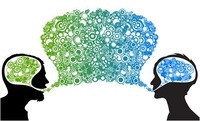
Professional Communication (Veterinary)
Quiz
•
Professional Development
•
9th - 12th Grade
•
Medium
Jennifer DeForge
Used 80+ times
FREE Resource
26 questions
Show all answers
1.
MULTIPLE CHOICE QUESTION
2 mins • 1 pt

Two major types of communication are:
Written & Perceived
Assumption & Perception
Verbal & Non-Verbal
Happy & Sad
2.
MULTIPLE SELECT QUESTION
2 mins • 1 pt

Example(s) of verbal communication: (choose all that apply)
Phone conversation
Smiling
Making eye contact
Writing an email
Using TikTok
3.
MULTIPLE SELECT QUESTION
2 mins • 1 pt

Non-verbal communication: (choose all that apply)
Listening to a voicemail and taking down a message
Face-to-face conversation
Having a telephone conversation
Making eye contact
Waving at someone
4.
MULTIPLE CHOICE QUESTION
2 mins • 1 pt

Which of the following is a barrier to effective communication?
Judgemental mindset
Not actively listening
Lack of professional (work appropriate) vocabulary
All the answers are barriers to effective communication
5.
MULTIPLE CHOICE QUESTION
2 mins • 1 pt

Which is NOT important for effective communication?
Being able to see someone during the communication process
Making eye contact when speaking/listening
Using appropriate body language
Using the appropriate tone and infections
Avoiding slang
6.
MULTIPLE SELECT QUESTION
2 mins • 1 pt

In order to comprehend a message, you must: (choose all that apply)
Use a telephone
Wear professional attire
Send a text message or email
Actively listen to the speaker
Consider the other person's point of view
7.
MULTIPLE CHOICE QUESTION
2 mins • 1 pt

All of the following are examples of active listening, EXCEPT:
Showing interest in the message, smiling
Focusing on the patient only and not on the client speaking
Making eye contact with the messenger
Not interrupting the messenger
Create a free account and access millions of resources
Similar Resources on Wayground

27 questions
Unit 1- Telephone Communication in the Medical Office Quiz
Quiz
•
12th Grade

25 questions
Life Skills
Quiz
•
12th Grade - Professi...

30 questions
Ch.13 Braiding and Braid Extensions
Quiz
•
12th Grade

21 questions
Chapter 7
Quiz
•
9th Grade

24 questions
Hair Cutting and Styling Quiz
Quiz
•
12th Grade

25 questions
SPCH 61 Building Confidence
Quiz
•
7th Grade - University

30 questions
Communication Skills-Mass Media Studies CBSE XII (Emp 1.1)
Quiz
•
11th Grade - Professi...

30 questions
Law of Agency Level 1-4 Quiz
Quiz
•
12th Grade
Popular Resources on Wayground

20 questions
Brand Labels
Quiz
•
5th - 12th Grade

10 questions
Ice Breaker Trivia: Food from Around the World
Quiz
•
3rd - 12th Grade

25 questions
Multiplication Facts
Quiz
•
5th Grade

20 questions
ELA Advisory Review
Quiz
•
7th Grade

15 questions
Subtracting Integers
Quiz
•
7th Grade

22 questions
Adding Integers
Quiz
•
6th Grade

10 questions
Multiplication and Division Unknowns
Quiz
•
3rd Grade

10 questions
Exploring Digital Citizenship Essentials
Interactive video
•
6th - 10th Grade
Discover more resources for Professional Development

20 questions
Brand Labels
Quiz
•
5th - 12th Grade

10 questions
Ice Breaker Trivia: Food from Around the World
Quiz
•
3rd - 12th Grade

10 questions
Exploring Digital Citizenship Essentials
Interactive video
•
6th - 10th Grade

20 questions
Distribute and Combine Like Terms
Quiz
•
7th - 9th Grade

12 questions
Graphing Inequalities on a Number Line
Quiz
•
9th Grade

11 questions
NFL Football logos
Quiz
•
KG - Professional Dev...

20 questions
Cell Organelles
Quiz
•
9th Grade

20 questions
Cell Transport
Quiz
•
9th Grade



